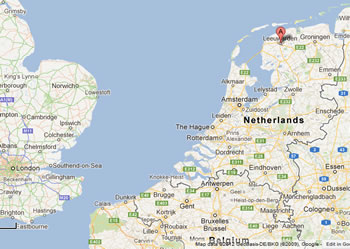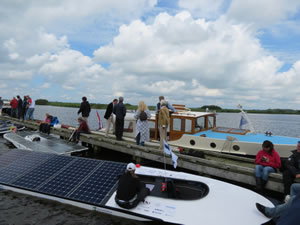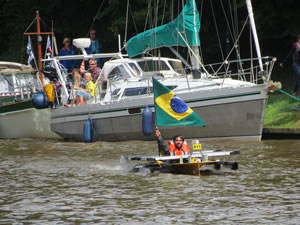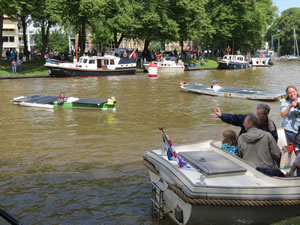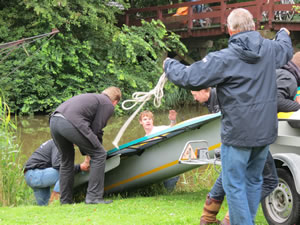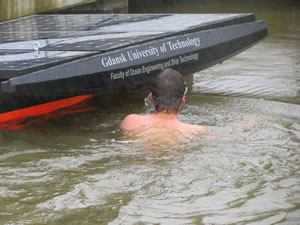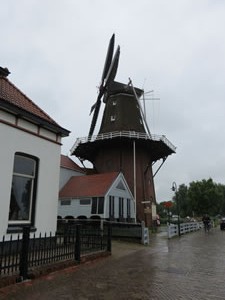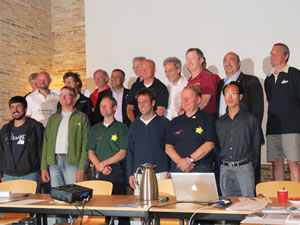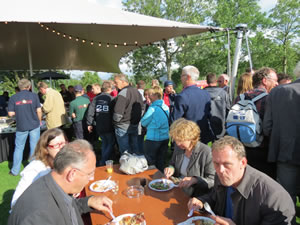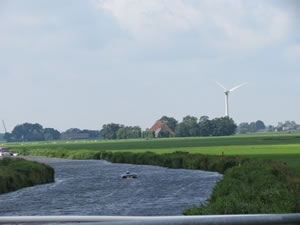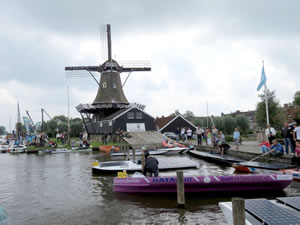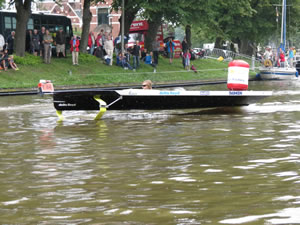The 2012 DONG Energy Solar Challenge
The DONG Energy Solar Challenge is a biennial solar boat competition held in The Netherlands. In 2012, Andries van Weperen and his wife, Joke (pronounced “yoke’-uh”), attended SOLAR SPLASH in Cedar Falls/Waterloo, Iowa. We learned a lot about the DONG event from them and decided it would be a good idea to attend the event and learn firsthand how their competition works.
David Luneau, SOLAR SPLASH Technical Manager and webmaster, and his wife, Terri (a “red-shirt” and photographer) traveled to The Netherlands to witness the event. In the entries below, you can follow their adventures through stories and photographs.
Thanks to the University of Arkansas at Little Rock Department of Engineering Technology and the College of Engineering and Information Technology for funding David’s portion of the trip.
Enjoy the story!
Saturday, July 14, 2012
Today was the grand finale of the DONG Energy Solar Challenge, with a relatively short 28 km run from Dokkum back to Leeuwarden where the event began last Sunday. We were invited aboard one of the “dignitary” boats, which we gladly accepted. The boat, pictured above, has been remodeled since it was initially constructed in the 1930s. Along the way we were able to see part of Leeuwarden from the canals, which was quite nice since most people that live on canals make the gardens on the canal side of their homes lovely.
We traveled from the finish line toward the start line and met the boats at the restart point – Grote Wielen. The purpose of the restart is to permit the boats to all arrive at the finish line at a predictable time and all within several minutes of one another. By the time the boats reached Grote Wielen, Private Energy had already more than made up the time difference to pass Cedarville, who ended up in third place in the top class (but tops among colleges). The boats were able to recharge for a while in Grote Wielen, depending on how soon they arrived, so that most of them had enough energy to sprint the final few km to the finish line.
The weather was sunny and beautiful today, which brought out a large Saturday afternoon crowd in Leeuwarden to see the finish. As each boat crossed the finish line, a small “cannon” was fired, and many of the teams waved flags. It was an exciting finish to a first-class event. After boats crossed the finish line, many of the skippers motored around showing off their boats. The two fastest boats in the top class, both of which used the same hull, even did some impromptu sprint racing against each other.
We met a high school teacher from the New York City area who teaches boating-related topics. He was interested in solar-powered boats, and so we discussed the DONG Energy event as well as Solar Splash. He was interested in learning more about Solar Splash, and we will talk further about site and event requirements.
For now we say “tot ziens” to The Netherlands. We thoroughly enjoyed the stay, the event, the people, the food, and so on. I hope we are able to return some day soon!
Friday, July 13, 2012
Teams faced some new challenges today. First, there was a steady light rain all morning and into the late afternoon. Along with the rain were overcast skies and limited sun. Second, there were two locks to be traversed. These locks are new – previously there were dams at these locations. The water in this section of Friesland’s canals is about one foot (about 30 cm) lower than in the rest of the province. We were told that this lower area was once sea, but was reclaimed in 1505 with dikes.
Not every team waits for the cranes to launch their boat. The process of launching 40 boats can take well over an hour, so the Vripack team took matters in their own hands.
The rain made for slippery footing and for muddy roads. We managed to find one of the only non-paved or non-bricked roads to park on and needed some help to get backed out after stopping at the first lock (or “sluice” as the Dutch call it). The DONG Energy competition organizers were generous enough to allow us to use one of their official vehicles during our visit to the competition. They have been very accommodating in every way.
Despite the cold, rainy conditions, several teams sent swimmers into the water to clear debris from their propellers or hydrofoils. The swimmers didn’t seem to mind the cold, but we were doing all we could to stay warm and dry with jackets and umbrellas.
The restart point for today was the beautiful town of Birdaard. Competitors, observers, and organizers began arriving there around lunch time and filled the town’s cafes and shops. We were glad to get out of the rain and sit in a warm, dry place for a while. All of the cafes where we have dined have had very good food at prices comparable to those in the United States. Birdaard has a working windmill. We visited there after lunch, talked with the couple that operates the windmill, and bought some bread mix from them. They were not grinding today since the wind speeds were fairly low, but they had ground yesterday. Note the thatched roof on the upper part of the windmill.
Today’s finish was in the eleventh, and final, city of Friesland – Dokkum. The first boats finished in drizzle, which soon turned to heavier rain. By the time the final boat crossed the finish line, the sun was shining! Cedarville is shown crossing the finish line in Dokkum. The team thinks the rain worked to their advantage, as they do not have the high speed of the other boats. With the DNF (did not finish) of the Delta Lloyd team, Cedarville has now moved into second place in the Top Class. However, the defending champion is just 18 minutes behind them, so they will have to move quickly in the short run tomorrow to stay ahead.
Thursday, July 12, 2012
Today we spent significant time with members of the technical team. Specifically, David traveled with Dennis Carton (above attaching a transponder to a boat), whose company GeoSports is charged with tracking and timekeeping. They install transponders on each boat each morning, and throughout the day the boats can be tracked on the internet as a result of the transponders, communication system, and software that GeoSports has developed. Terri traveled with Dennis’ assistant Linda, who is charged with “tweeting” about the event and updating other social media. We both learned a lot about the use of technology at the DONG Energy event, and we learned a lot more about the region, its history, and its people.
One recurring theme about the culture of this area is that they are proud of their history, and they don’t tend to tear down older structures. For example, the retired smokestack in the picture to the right has been repurposed as a cell phone tower. We also noticed that you see very few powerlines in Friesland – just the occasional high voltage transmission line. They explained that the Dutch value neatness, and so almost all powerlines are underground. This also reduces outages caused by wind and ice.

Timing is done electronically using a web interface. Times are written on paper as a backup. The timer at the finish line presses a “button” on a web page when a boat crosses the finish line, which logs the time of the boat’s finish. If two boats arrive close to the same time, the timer reads the second time to another person, who records the time on paper and updates the system later.
The transponder tracking system sends updates via the cell network to a server in Rotterdam that updates the location of each boat every second. The positions are displayed on the event’s website, so that anyone with internet access can track the position of each boat. At the finish line today in Franeker, the map was displayed on the big-screen television for all to see. The boats are color-coded with colors that match the actual color of the boat. If you click on the picture to the right to enlarge it, you will be able to see several boats along the canal headed toward the finish line.
The team from Brazil crossed the finish line in Franeker. They are a second-time competitor in The Netherlands, and they have been involved in two solar-powered boat competitions in Brazil.
Most of the teams camp at the end of the day. The race organizers arrange camping areas in or near the city where the race ends each day. As you can see from the large tents and satellite dish, they aren’t all “roughing it”.
After a long day of activities, we attended an international discussion on cooperation in solar boating. Representatives from The Netherlands, Brazil, Finland, Belgium, Poland, Jordan, Bahrain, China, and the United States were present. We agreed to share ideas and support the efforts of one another. We also discussed the September workshop in Bahrain to prepare for a planned solar boating competition to be held there in March 2013.
Wednesday, July 11, 2012
Today was a scheduled rest day. The teams got to relax from the daily chore of driving and keeping up with their boat, and they got the opportunity to work on repairing problems and show off their boat to sponsors, officials, and guests. Above, students from Antwerp (Belgium) Maritime Academy explain the building of their boat to David.
David met with Joris Melkert (top) of Delft University, head of the technical committee. They shared ideas and stories of rules and inspections. Dennis Carton (above) of GeoSports is responsible for the transponders on each boat that continuously relay location information that is streamed to the event’s website. Dennis invited us to travel with him and his crew tomorrow to see how they operate.
The people of Holland, and especially those of Friesland Province, are very knowledgeable and proud of their heritage. Wooden shoes are a reminder of the Dutch past, and they can be found in many colors and styles. The symbols on this shoe are the provincial symbol of Friesland (the province in which the event is run), and they are in the shape of the leaves of the yellow water lily. Historically there were eleven “cities” in Friesland, and the event runs through all eleven of these historic cities. Frisian people even speak their own language, in addition to Dutch, English, and often others. All city signs, as well as many road signs, are shown in both Friesian and Dutch, not that either of those helps us much.
Dinner was a “barbecue” provided by one of the many event sponsors, Energy Valley Solar.
There were some speeches by award judges and local dignitaries before dinner and a live band that entertained the participants and guests as they ate. Again we were grateful to be invited to participate in the meal and festivities.
Tomorrow morning the boats go back in the water for the third of five race legs. The route takes the boats from Bolsward to Harlingen, where they will restart at 2:00 pm for a finish in Franeker. Tomorrow evening at the Franeker Management Academy there will be a meeting of representatives of various solar-powered boat competitions from around the world to discuss goals, differences in rules and regulations, and ways to advance international cooperation. We are looking forward to this “global summit”.
Tuesday, July 10, 2012
The weather again foiled predictions, and the second leg of the race began under beautiful blue skies, which promised great energy-gathering potential for the day. Today was the longest day of racing (56 km) and included a variety of “habitats”. An innovative camera crew was on hand for the start with a flying video camera that performed flawlessly.
Early in the day the teams were faced with traversing a segment of a very narrow, tree-shaded canal. While the area was picturesque, the teams had to use quite a bit of stored battery power to get through this 7-km segment. Passing other boats proved difficult during this leg of the journey.
One of the challenges of traveling along Holland’s canals is dealing with other, larger boats which take up a lot of space and require the opening of many drawbridges along the way. The competition boats ride low enough in the water to travel under the bridges without waiting for the drawbridge to open.
During the early afternoon break, the boats gathered in Workum waiting for the 4:00 pm restart. The early arrivers took advantage of the partly sunny skies and employed various techniques to aim their solar panels at the sun. Each day the boats gather at a stopping point in the afternoon a few kilometers from the day’s finish line to ensure that all boats arrive at the finish line in a fairly narrow window of time. This permits onlookers at the finish line to see the boats without having to wait around.
The leader of the competition, a hydrofoil boat made by the company Private Solar from Leeuwarden in The Netherlands, was the first boat to be restarted in the afternoon. Somewhere between the restart in Workum and the finish line in Bolsward, the boat’s motor failed, knocking them out of the competition. This illustrates that in addition to innovation and great design, reliability is a key factor in the final results of the competition.
The day ended at Bolsward, and the teams trailered their boats to a paddock area near the campground where most of the teams will spend the night. Tomorrow is a “day of rest” where the teams will be able to make any needed repairs to their boats, and they will get to show off their boats to sponsors and other interested guests. There will be some events for local children and an evening barbecue for teams and sponsors.
Participants are served three meals a day, which keeps a cooking crew quite busy. We were invited as guests to dinner tonight and were impressed with the quality of the food and the efficiency of service. The logistics of the competition requires many groups of volunteers, who perform various tasks. Color-coordinated shirts distinguish the different groups of officials.
Dinner conversation was quite lively as we discussed collaboration on future solar boat competitions. Waheeb Alnaser of the University of Bahrain and Mohammed Al-Taani of Jordan are also attending the DONG Energy competition as observers. Waheeb is in the process of planning a similar event to take place in March of 2013 in Bahrain. We will be discussing this event in more detail later this week.
This evening ended, as each evening does, with a presentation of awards for the three fastest boats of the day in each division. The awards are presented on a podium that was designed and constructed specifically for this event. It is a portable, trailered amphitheater that is moved to the ending location of each day’s competition.
Monday, July 9, 2012
Boats, teams, spectators, and dignitaries gathered again in Leeuwarden’s Prinsentiun to start the first of five days of cross-country racing. Breezy but dry, the weather was cooperative as the solar competitors lined up for the running start. The clouds thinned and the sun came out on several occasions, brightening the day for the everyone and giving the solar panels a chance to show off their power.
The boat from Leeuwarden’s sister city of Liyang, China, was cheered on by an exuberant mascot that drew attention from many of the spectators. The mayor and a delgation from Liyang were present, and the mayor was permitted to give the official start for the Chinese entry.
As the boats pulled away from Leeuwarden on the canals, we drove south of town to a bridge where we could observe the boats as they raced through the Frisian countryside. Reporters and camera crews managed to obtain real-time interviews with some of the skippers.
Modern windmills and the solar powered boats offered two examples of how people in this area are striving to obtain sustainability. The people of The Netherlands seem very in tune with the concepts of energy conservation and alternative energy. Driving is tricky because there are as many bicycles and pedestrians as there are automobiles to watch out for. We also saw solar panels on many houses and farm buildings, and there are quite a few commercial electric boats in use on the canals.
Locals gathered with us on the bridge to cheer the skippers and enjoy the spectacle. We had a nice conversation with a dairy farmer who had come to watch the boats go by. He was quite impressed by the speeds of some of the boats. This part of The Netherlands is very flat, and virtually all of the land is within 1 meter of sea level. The water in all of the canals in Friesland is kept at approximately the same level, which fluctuates very little over time (perhaps only as much as 10 cm or 4 inches). We witnessed a pump automatically turn on, pump for a while, and turn back off, moving water from a smaller canal (a ditch, really) into this main canal.
The morning run ended at the town of Sneek (pronounced “snake”) where the boats took a break for lunch. Spectators who gathered around the canals were able to view the boats and visit with crews. Later the boats were restarted for the afternoon run. The archway with the twin spires in the background was built in the 1400s as part of the defense of the town. The small cross-shaped portholes in the towers were used to fire arrows from.
Gusty winds required a course adjustment and the boats were not allowed to traverse the turbulent Slotermeer lake for safety reasons. The day’s racing ended instead at Woudsend. Project Director Albert Bosscha told us that he wanted to start tomorrow with the same number of boats that started today. In other words, he did not want the Slotermeer to consume any of the competitors. The decision to shorten the day was made at noon, so teams had to adjust their afternoon energy management plans, as teams had been conserving battery energy in the morning for the long crossing of the lake.
The Midnight Sun, the team from Finland, is a new competitor. They told us that they are currently in third place in the “B” class – the two-person class. Rumor has it the team brought their own sauna! For complete race results and standings from day 1, check out the DONG Energy site update for today.
Removing boats from the canals required large cranes that lifted the boats from the water and gently lowered them onto their trailers. The two cranes move with the competitors each day and put the boats in the water in the morning and remove them from the water each evening.
Sunday, July 8, 2012

The DONG Energy Solar Challenge competition officially opened this afternoon. The event was held in the town of Leeuwarden in The Netherlands on the main canal that runs through downtown. Despite the slow, but persistent, rain, many people showed up to see the competitors perform in a 200m sprint and to hear Iris Kroes, a popular Netherlands singer, sing the “Solar Song” and a few other numbers. Flags representing many of the countries competing this year were waved by local children to welcome the competitors.
After the opening ceremonies, the sprinting began. Boats ran the 200 m straight course in pairs as fast as they could. Order of finish in the sprints determines the positions for starting the competition tomorrow. The four fastest boats each ran in an additional heat. See the DONG site for sprint times and order of finish. The canal was an exciting place today as there were 40 solar-powered competitors as well as many officials’ boats, many of which were eletric and/or solar-powered.
Several boats used hyrdofoils, which are designed to lift the hull of the boat out of the water, thereby decreasing drag on the hull. The boat shown to the left, built by the Delta Lloyd Solar Boat team of Delft, used hydrofoils successfully in the sprints. It will be interesting to see how well the boats using hydrofoils do in the day-to-day long distance competition.
Tomorrow’s events begin at 10:00 local time in Leeuwarden at the same place the sprints were held. This location also serves as the finish line next Saturday. In between, the boats will travel 220 km around the canals in Friesland. We will follow them and try to get some technical information on the leaders. Stay tuned.
Saturday, July 7, 2012
We will be arriving in The Netherlands on Sunday, just in time for the sprint trials as the event gets underway. Meanwhile, we are traveling and looking forward to watching and enjoying the competition.
Looking at the 10-day weather forecast for Leeuwarden, Netherlands (northeastern part of the country), is a bit depressing from the point-of-view of a solar-powered competition. Although the forecast, as forecasts tend to do, has been shifting around quite a bit, the one constant prediction has been for rain. Anywhere from 60% to 100% chances are predicted for most days of the competition. I assume that this means the times will be slower than they have been in years past. I hope that the teams have prepared for rain and are planning their strategies accordingly.
Here is a map of the event to give you some perspective.
